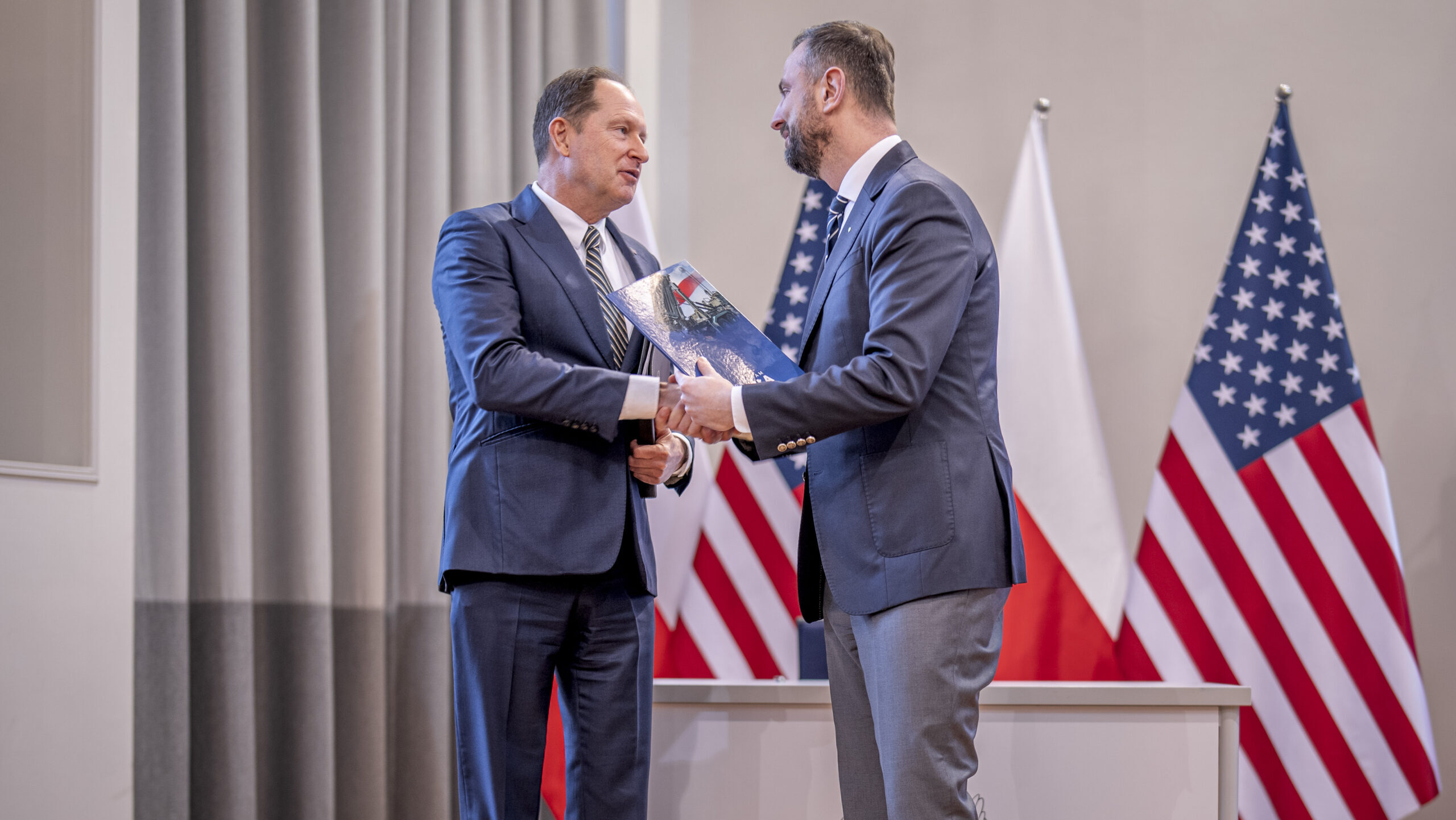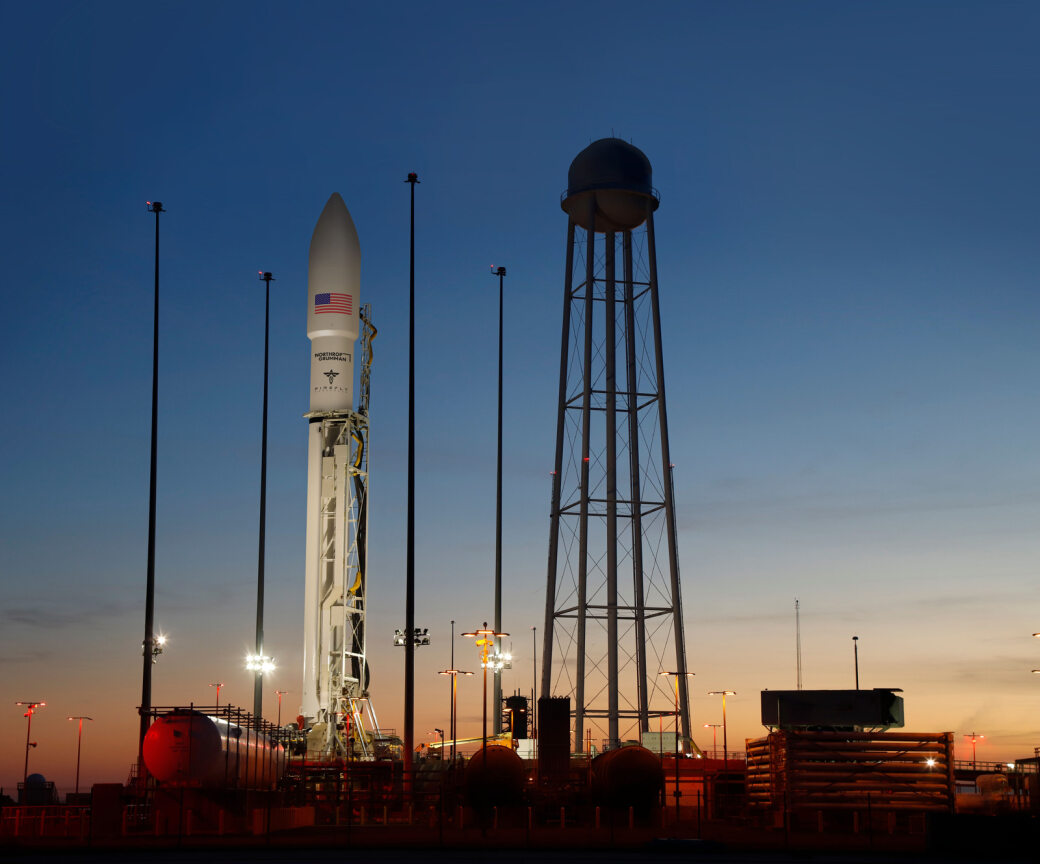
U.S. Ambassador to Poland Mark Brzezinski and Poland’s Minister of National Defence Władysław Kosiniak-Kamysz holds the signed Letter of Acceptance for the Integrated Air and Missile Defense Battle Command System (IBCS) Feb. 29 in Warsaw, Poland. (U.S. Army photo by Sgt. Yesenia Cadavid).
WARSAW — Poland on Thursday inked a $2.5 billion deal for an American Integrated Air and Missile Defense Battle Command System (IBCS), the second phase of the nation’s Wisla and Narew air defense programs.
The signing, attended by top Polish defense officials and the US ambassador to Poland, came just a day after the Polish Ministry of National Defense announced a framework agreement for a fleet of 286 new light armored reconnaissance vehicles from a consortium of Polish entities led by auto maker AMZ-Kutno.
In the IBCS announcement, Poland’s Minister of National Defense Wladyslaw Kosiniak-Kamysz said that today is a “great day for Poland, a great day for the United States, a great day for NATO, a great day for our security.”
Wojsko Polskie otrzyma najnowocześniejszy system dowodzenia obroną przeciwlotniczą i przeciwrakietową
–
Wicepremier W. @KosiniakKamysz: Wielki dzień dla Polski, wielki dzień dla Stanów Zjednoczonych, wielki dzień dla NATO, wielki dzień dla naszego bezpieczeństwa. Tu i teraz… pic.twitter.com/k47AcyvsIX— Ministerstwo Obrony Narodowej 🇵🇱 (@MON_GOV_PL) February 29, 2024
The deal for IBCS, which is primarily made by Northrop Grumman, includes command and communications equipment to work with six Wisla air defense systems — the Polish name for Patriot systems — and 23 Narew short-range air defense (SHORAD) systems, made by a partnership between MBDA UK and Polish industry. The IBCS deal is scheduled to run from this year to 2031.
“Defending our airspace is a key issue for our government and the Ministry of National Defense,” Kosiniak-Kamysz said. “The Wisla and Narew programs will be the most modern in the world. We will be the second country after the United States with this integrated and state-of-the-art command system [IBCS].”
The contract includes the purchase of selected communication devices for the Wisla and Narew systems, passive IFF systems, cryptographic devices, implementation of work on software, expansion of laboratory infrastructure, integration of the radars for the Wisla and Narew systems and the NAREW launchers within the IBCS system, as well as the implementation of post-integration field tests covering the interaction of all elements of the Narew and Wisla. The contract also assumes logistical and technical support and a stock of spare parts.
The US State Department approved a potential larger IBCS deal with Poland in September 2023, that one worth an estimated $4 billion.
Earlier this month, the Polish government signed a $75 million offset deal linked to the IBCS arrangement with a Northrop entity that included the integration of the multimode fire control radars called “Sajna” and the redeployable “Bystra” radars for the Narew with the IBCS, the transfer of the ability to produce new types of ammunition for Bushmaster cannons used in KTO Rosomak and IFV Borsuk, 120mm ammunition used by M1 Abrams MBTs, and ammunition for the 30mm M230 chain gun of AH-64E Apache attack helicopters.
Framework For Recon Vehicles
The IBCS announcement followed another from the Polish government on Wednesday, that one concerning a framework agreement to acquire a fleet of nearly 300 new recon vehicles by 2035.
The military is buying 286 light armored reconnaissance carriers (LOTR) after witnessing the importance of reconnaissance on the battlefield in Ukraine.
“The war in Ukraine showed how important the ‘eyes and ears of the army’ are,” Kosiniak-Kamysz said.
Blisko 300 lekkich opancerzonych transporterów rozpoznawczych Kleszcz – dzieło 🇵🇱 myśli technologicznej – trafi do polskiej armii. Dziś podpisaliśmy w tej sprawie umowę ramową z AMZ-Kutno. Wspieramy polski przemysł obronny. Chcemy w nim wydawać 50% środków na modernizację armii. pic.twitter.com/0nwGH4pJ0F
— Władysław Kosiniak-Kamysz (@KosiniakKamysz) February 28, 2024
The new vehicle is intended to replace the BRDM-2 amphibious armored scout car and their Polish modifications, such as ”Żbik” (“Wildcat”) and “Szakal” (“Jackal”), still used in the Polish Land Forces. These vehicles are over 30 years old, based on Soviet designs, and are not believed to provide adequate protection in a modern fight.
The LOTR project was part of the “Operational Patrol Reconnaissance” program, which is an element of the Technical Modernization Program of the Poland’s Armed Forces for 2013-2022 and continued as part of TMP 2021-2035.
Seven meters long, 2.5 meters wide and 2.4 meters high LOTR is 4×4 amphibious wheeled vehicle that can carry five soldiers and go 90 km/h on a paved road, according to the Polish government. The lighter of two variants of the vehicle can float in water and travel 7 km/h on water.
The vehicle’s extensive equipment, including a tactical battlefield reconnaissance radar, an optoelectronic turret as well as a communication and data processing subsystem can be used to process and transmit encrypted reconnaissance data.
The two acquisitions mark the latest in Poland’s defense spending spree, spurred by Russia’s invasion of Ukraine and colorfully described by a senior Polish military official to Breaking Defense previously: “We just took our suitcases with money and [are] going like hell around the world and trying to buy.”












